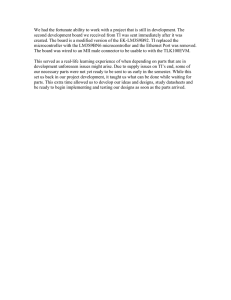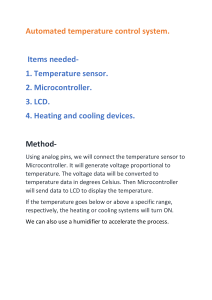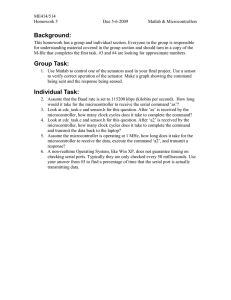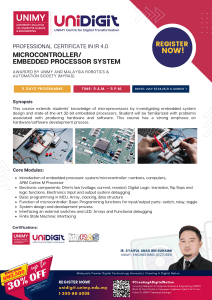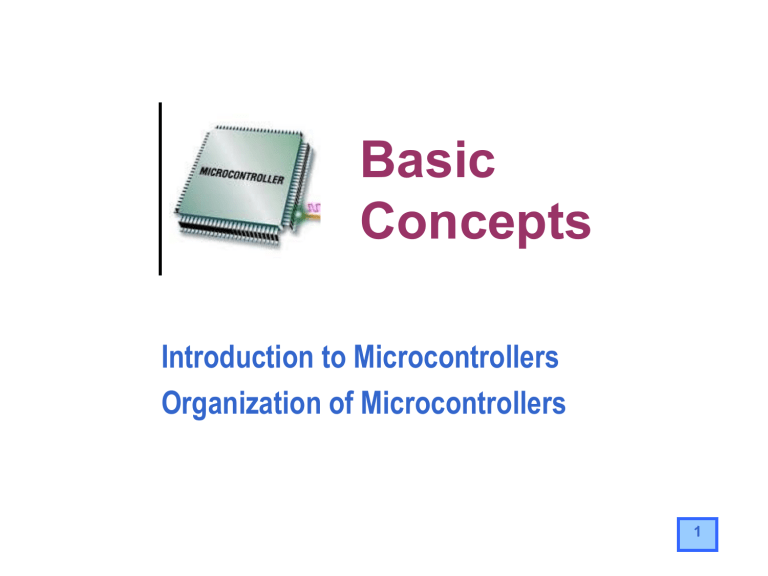
Basic Concepts Introduction to Microcontrollers Organization of Microcontrollers 1 What is a Computing System? Hardware & Software CPU Control unit Arithmetic Logic Unit Registers communication bus MEMORY Program Storage Data Storage OUTPUT UNIT INPUT UNIT 2 Components of Computer Systems 3 What is a Microprocessor ? Pentium 4 microphotograph 4 Microprocessor Structure 5 Microprocessor Basic Operation Program (instructions) and Data are stored in Memory Each instruction is read (fetched) from memory, interpreted (decoded), and executed Arithmetic Logic Unit (ALU) performs operations on data Data is transferred (register, memory, I/O) Program Counter (PC) indicates current location of program in Memory and is automatically incremented after each instruction Each instruction can take several clock cycles Fetch Decode Execute 6 What is a Microcomputer System? It is a computing system based on microcontroller. 7 Microcontroller System The buffers and converters condition I/O signal levels if necessary The bus is a group of signals (data, address, control signal) with a common purpose. The clock circuit generates a fixed-frequency, timing signal for the entire system. The power supply converts a raw power source into the DC voltage (nominally 5V) required by the system. 8 An example of microcontroller system (MC68HC11EVBU evaluation board) 9 Microcontroller Integrated system designed to operate as an embedded computing system ( a computer which is part of a larger system) A microcontroller is a small, low-cost and self contained computer-on-a-chip that can be used as an embedded system. It is composed by: microprocessor (CPU), ROM (for the program), RAM (for the data) I/O ports (to communicate/interface with external resources), Peripheral devices (to make easier the interfacing and implementation of the desired functionalities), 10 Common Applications Consumer: Communication: Washing machine, Remote controls Clocks and watches Games and Toys Audio/video Telephone systems, Answering machines Cell phones and pagers Networking (ATM, credit cards, Ethernet) Automotive: Safety devices (Automatic Braking System, Airbag) Motor control (ignition, exhausts) Power windows and seats Instrumentation 11 Common Applications Military: Industrial: Guidance systems Global positioning systems Target recognition systems Traffic control Robotics Production plants Inventory and stock management Medical: Cardiac monitors Renal Monitors Pacemakers Dialysis machines 12 Classification of Microcontrollers The microcontrollers are characterized by their: bits, bus-width, instruction set, and memory structure. 13 Classification According to Number of Bits In 8-bit microcontroller, the point when the internal bus is 8-bit then the ALU is performs the arithmetic and logic operations. The 16-bit microcontroller performs greater precision and performance as compared to 8-bit. For example 8 bit microcontrollers can only use 8 bits, resulting in a final range of 0×00 – 0xFF (0-255) for every cycle. In contrast, 16 bit microcontrollers with its 16 bit data width has a range of 0×0000 – 0xFFFF (0-65535) for every cycle. The 32-bit microcontroller uses the 32-bit instructions to perform the arithmetic and logic operations. These are used in automatically controlled devices including implantable medical devices, engine control systems, office machines, appliances and other types of embedded systems. 14 Classification According to Memory Devices Embedded memory microcontroller: When an embedded system has a microcontroller unit that has all the functional blocks available on a chip is called an embedded microcontroller. For example, 8051 having program & data memory, I/O ports, serial communication, counters and timers and interrupts on the chip is an embedded microcontroller. External Memory Microcontroller: When an embedded system has a microcontroller unit that has not all the functional blocks available on a chip is called an external memory microcontroller. For example, 8031 has no program memory on the chip is an external memory microcontroller. 15 Classification According to Memory Architecture Harvard Memory Architecture Microcontroller: The point when a microcontroller unit has a dissimilar memory address space for the program and data memory, the microcontroller has Harvard memory architecture in the processor. Princeton Memory Architecture Microcontroller: The point when a microcontroller has a common memory address for the program memory and data memory, the microcontroller has Princeton memory architecture in the processor. Harvard Architecture Princeton Architecture 16 Microcontroller Architecture 17 Microcontroller Organization RESET CLOCK I/O Processor ROM RAM I/O INTERFACE MICROCONTROLLER (SINGLE CHIP) PIO INT UART SIO GPT PWM WDT AIO 18 Microcontroller Functional Units CPU: Central Processing Unit (4,8,16,32 bit data bus) ROM: Read Only Memory (Firmware) RAM: Random Access Memory (Register File, Processor Stack, Temporary data) PIO: Parallel I/O (relays, sensors) INT: Interrupt Inputs (external/internal sources) UART: Universal Asynchronous Receiver Transmitter (e.g. RS232) GPT: General Purpose Timer (optional event counter) PWM: Pulse Width Modulator (motor controller) WDT: Watch Dog Timer (automatic reset) AIO: Analog I/O (ADC & DAC) 19 Memory basic concepts Digital data is stored in the form of binary numbers, however it is often represented using the hexadecimal numbering system. The bit is the smallest digital unit, and is either 1 or 0. A byte is defined to be 8 bits. A word varies from processor to processor and can be 8, 16, 32 or more bits. Normally, the byte is the smallest addressable unit; however, it is possible to address individual bits in I/O registers. Motorola convention: binary number are prefixed by % and hexadecimal numbers by $ 20 Memory basic concepts 21 Memory Types The main types of semiconductor memory are: ROM – Read Only Memory RAM – Random Access Memory EPROM – Erasable Programmable Read Only Memory EEPROM – Electrically Erasable Programmable Read Only Memory 22 The Bus The bus provides the communication infrastructure among the various components of the system Data bus carries the information being transmitted/received. Address bus tells where the information is being transferred to/from. Control bus specifies when the information transfer take place by coordinating the access to the data bus and the address bus, and directs the data from/to the specific components. 23 Motorola 68HC11 The 68HC11 is a family of 8 bit microcontroller (MCU). The chip used in this class is: MC68HC11E1CFN2 24 68HC11E Pin Assignments 25 Thank you for Attention !
